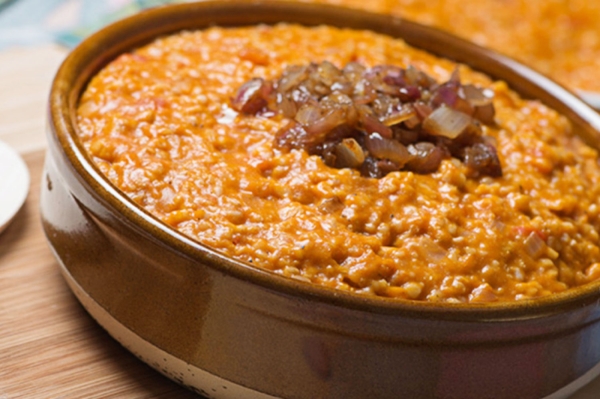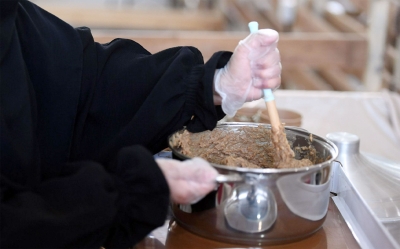

Traditional Food in Al-Jawf Province refers to the most renowned dishes in Al-Jawf Province, located north of the Kingdom of Saudi Arabia. These dishes are known for their common ingredients for locals. These dishes include al-Jawf Marqooq, al-Mathan bread, and Jareesh with ghee. Bakeelah is a popular dessert in al-Jawf Province. It consists of collected sweet dates to which opophytum and ghee are added and kneaded before being served to guests.
Ingredients of traditional food in al-Jawf Province
The ingredients of traditional food in Al-Jawf Province predominantly consist of whole wheat flour, ghee, and milk. Wheat flour is the main ingredient for most of the province's dishes. The traditional dishes in Al-Jawf Province reflect the historical heritage and the cultural diversity influenced by the province's status as one of Saudi Arabia’s border provinces.
Bakeelah: The regional dish in Al-Jawf Province
In 2024, the Culinary Arts Commission designated Bakeelah as the regional dish of Al-Jawf Province as part of the initiative Narratives of National and Regional Dishes. This initiative, launched in early 2023, identified Jareesh as the national dish of Saudi Arabia and Al-Maqshush as the national dessert.
The initiative aims to celebrate Saudi culinary culture, document its recipes, and invest in its symbolic value to promote its dissemination across various social groups locally and abroad, preserving it as an integral part of Saudi Arabia’s cultural heritage.
Bakeelah is locally known as Al-Batseelah. It is a hospitality dish, generally served by the inhabitants of the northern part of Saudi Arabia on various occasions. It consists of opophytum flour, collected from desert areas neighboring Tarbarjal Governorate after rainfall. Its grains are soaked in water for more than fifteen hours. Grains are then extracted, ground, and prepared for kneading with pitted sweet dates collected from Al-Jawf Province. Other ingredients are added to the mixture, including olive oil and wild ghee, depending on personal preference. The dish is served with coffee throughout all seasons of the year. However, the demand for Bakeelah increases during winter, as it contributes to supplying the body with energy and warmth.
Al-Jawf Marqooq dish
Al-Jawf Province shares many similarities with Saudi Arabia's northern provinces in terms of preparing Al-Jawf Marqooq dish, Matazeez, Al-Qursan, or Al-Mulla disk. These dishes are made from nearly the same ingredients but differ in the preparation of the dough, how it is cut, and how it is incorporated with the other components. They share the process of cutting the dough and mixing it with broth, vegetables, and spices until fully cooked.
The traditional dishes found on tables in Al-Jawf Province include the Tatmaj dish, usually served during winter because it is a satisfying and heavy meal in terms of its ingredients. It consists of jareesh, chickpeas, and cowpeas. Another dish is Maliha or Mulaihi, mostly known in the northern regions of Saudi Arabia. It consists of rice, Jameed, ghee, and meat. It is made upon preparing the required quantity of meat, washing it thoroughly, then adding hot water, and boiling the mixture before adding jameed or ghee while rice is cooked in a pot. Other popular dishes in Al-Jawf Province include Fatteh, served as breakfast because it is rich in fat. It is also prepared for eating during long winter nights. It is prepared by cutting bread into small pieces before soaking the pieces in milk.
Breads in Al-Jawf Province
Arboud bread is one of the preferred meals of bedouins residing in the desert north of Saudi Arabia, specifically in Al-Jawf. This type of bread is rich in essential nutrients for the human body. It helps individuals feel full for long periods. Hence, due to the scarcity of food among bedouins, it was eaten at dawn to create a feeling of fullness throughout the day. Some prefer to eat Arboud bread with milk, ghee, olive oil, or cheese, while others prefer adding honey or dates, especially the sweet dates found in Al-Jawf, among other toppings.
Arboud bread consists of pure whole wheat flour, water, and salt. The ingredients are mixed to form a homogeneous dough that is cooked on coals for half an hour at least, where cooking time depends on the mixture quantity and air temperature at the time of preparation. Preparation methods vary from one region to another. Initially, the dough was placed in a circular dish and rolled to form circular pieces. The dough was cooked upon placing coals thereupon to dry the mixture from water and enhance its cohesion, ultimately ensuring that sand and impurities do not stick to the dish or mixture. However, modern and innovative types of dishes are used today, such as tin and clay pots, as an alternative to the traditional cooking method. The mixture is then placed in what is known as Al-Mullah, which is heated pure sand until cooked.
Other popular breads in al-Jawf Province include Al-Mathan or Saj bread. This type of bread is served with tea. It is always served in Al-Jawf Province, namely on holidays, where women brag about the loaf size and preparation speed. In this respect, all the ingredients are kneaded until a dough is formed. The dough is left for fermentation. It is then cut into circular pieces and twisted using arms to form one large circle. It is then cooked on a griddle until its color changes. Once cooked, the loaf is removed and served.
Traditional food festivals in al-Jawf Province
Various events, such as the Olive Festival and Al-Jawf Dates Festival, are held annually, featuring sections for productive families interested in selling traditional dishes from Al-Jawf Province. These sections showcase the efforts of productive families in preparing and presenting traditional dishes in various ways that reflect the culture of each family.
Related quizzes
Related articles

